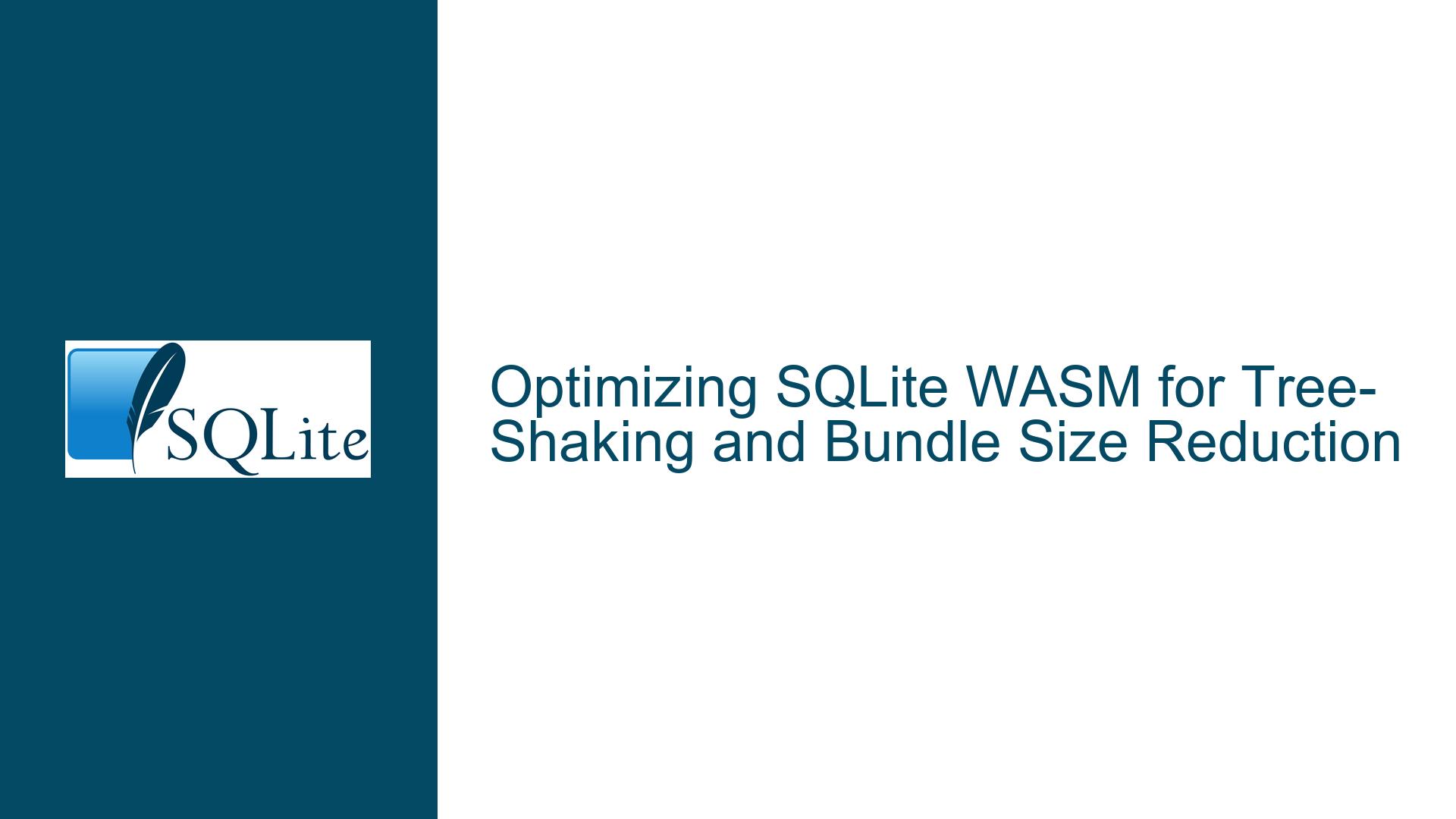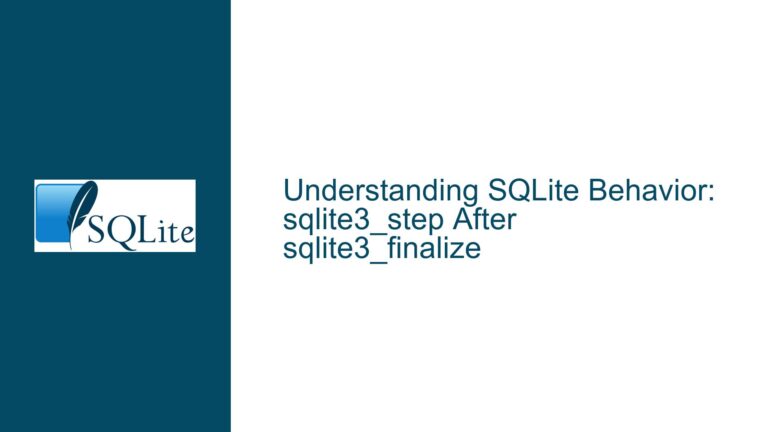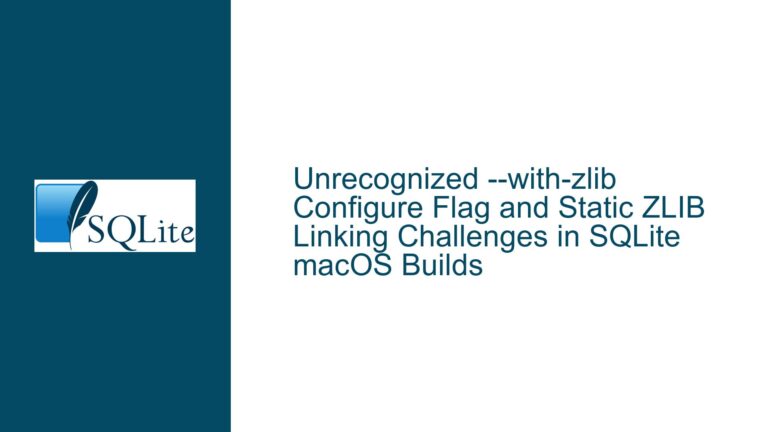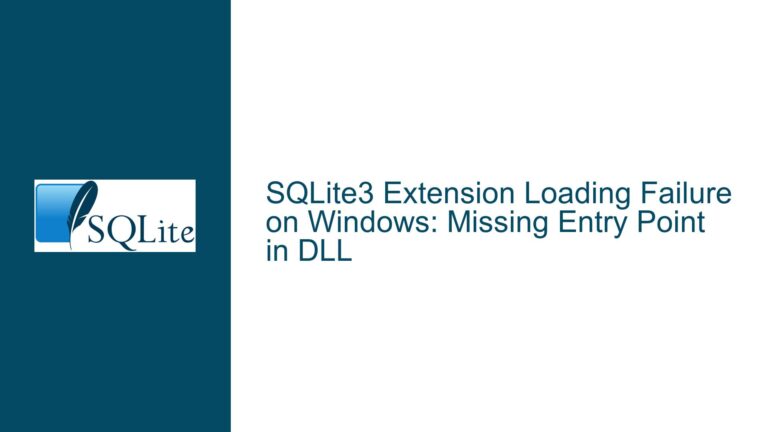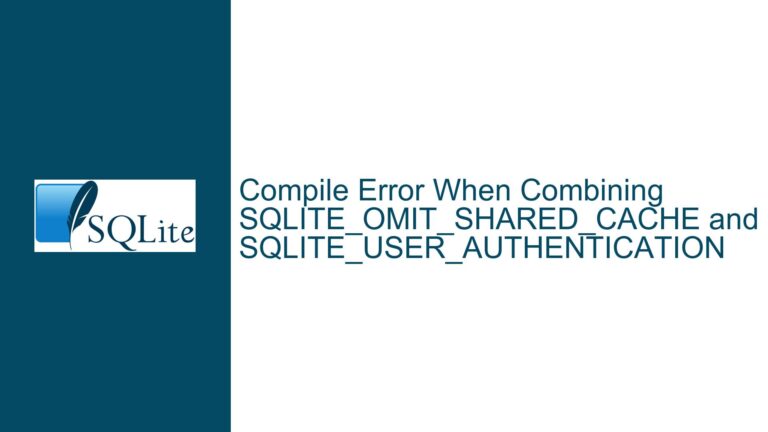Optimizing SQLite WASM for Tree-Shaking and Bundle Size Reduction
Structural and Architectural Barriers to Tree-Shaking in SQLite WASM
The SQLite WASM implementation faces intrinsic challenges in enabling tree-shaking due to its design philosophy and technical implementation choices. At its core, the project prioritizes backward compatibility, runtime flexibility, and minimal reliance on third-party toolchains – all of which inadvertently create barriers to dead code elimination during bundling.
Glue Code Coupling and Function Overloads
The JavaScript glue layer binding the WASM module to higher-level APIs employs aggressive function overloading to accommodate diverse input types and execution environments. For example, the sqlite3_exec() wrapper accepts multiple argument patterns: callbacks as functions or null, result formats as objects or raw arrays, and error handling through exceptions or return codes. This flexibility manifests as branching logic within monolithic function bodies rather than discrete exported functions. Bundlers cannot statically analyze which code paths are actually used by downstream consumers, resulting in entire functions being retained even when only a subset of their functionality is utilized.
The jsFuncToWasm utility exemplifies this anti-pattern. It dynamically reverses argument order in certain contexts to improve readability for specific use cases, creating implicit dependencies between call signatures. While pragmatic for human-centric development, this approach obscures function boundaries required for effective tree-shaking. The sqlite3-api-glue.js and sqlite3-v-helper.js modules further exacerbate the issue by centralizing cross-cutting concerns like type conversion and VFS initialization, creating a dense dependency graph resistant to static analysis.
Emscripten Toolchain Constraints
SQLite’s WASM build relies on Emscripten’s runtime system for POSIX I/O emulation and memory management. The generated sqlite3.wasm file imports 35+ environment-specific functions (e.g., wasi_snapshot_preview1.fd_write) that are satisfied by Emscripten’s JavaScript glue code. This creates an inseparable link between the WASM binary and its companion JS runtime – even when features like filesystem access are unused. Attempts to eliminate unused imports via tree-shaking fail because bundlers cannot safely determine which imports are reachable after dynamic code paths like WebAssembly.instantiate().
Moreover, Emscripten’s function mangling for minimal builds (_sqlite3_prepare_v2 vs. human-readable names in debug builds) obfuscates symbol resolution. Developers seeking to directly interact with low-level exports must either preserve the entire Emscripten runtime or manually reconstruct type definitions – both of which negate tree-shaking benefits.
Reference Implementation Bloat
The reference implementations of Object-Oriented APIs (oo1), Worker-proxied execution (worker1), and OPFS VFS integration add ~95KB of post-gzip JavaScript that cannot be easily partitioned. These layers build atop the core API with opinionated patterns like automatic statement finalization and synchronous promise resolution. While valuable for demonstrating best practices, they’re implemented as tightly coupled stateful classes rather than composable functions. Consequently, importing even a single utility method from oo1 transitively pulls in the entire class hierarchy and its supporting glue code.
Upstream Maintenance Philosophy and Integration Challenges
The SQLite core team’s operational constraints and philosophical stance on dependencies directly impact the feasibility of upstream tree-shaking support.
Anti-Breakage Culture and Versioning
SQLite’s legendary backward compatibility guarantees extend to its WASM artifacts. Once an API is published, it’s preserved indefinitely – even when suboptimal design decisions are later recognized (e.g., argument order ambiguities in jsFuncToWasm). This policy ensures stability for existing users but fossilizes architectural decisions that hinder tree-shaking. For instance, replacing overloaded functions with discrete, single-responsibility exports would require deprecation cycles spanning years, which the team considers prohibitive given their limited maintenance bandwidth.
Node.js/NPM Ecosystem Neutrality
The core team explicitly avoids deep integration with Node.js or modern JS toolchains (Webpack, Vite, Rollup). Their development environment relies on plain text editors without IDE-assisted type checking or bundler integrations. Consequently, JSDoc annotations and runtime type coercion are written for human readability rather than machine consumption. Tools like TypeScript compilers or @babel/preset-typescript struggle to infer accurate type boundaries from the existing docs, leading to incomplete or incorrect .d.ts generation when third parties attempt automatic extraction.
NPM Subproject Governance
While the official SQLite NPM package is maintained under the project’s umbrella, its development is delegated to contributors versed in modern JS ecosystems. This creates a bifurcation:
- Core WASM Artifacts: Built via Emscripten with zero NPM dependencies, targeting vanilla ES6 modules.
- NPM Package: Includes Node.js-specific glue code, CommonJS/ESM bridges, and type declarations that may drift from core implementations.
Proposals to upstream tree-shaking improvements must navigate this split. Changes to core artifacts (e.g., decoupling the OPFS VFS from sqlite3-api-glue.js) require approval from WASM maintainers like Stephan Beal, while NPM-specific adjustments (like Rollup configurations) fall under Thomas Steiner’s purview. This division of responsibility often results in stalled contributions that need synchronized approval from both custodians.
Mitigation Strategies and Custom Build Workflows
Developers can minimize bundle sizes without upstream changes through targeted build process modifications and architectural workarounds.
Emscripten Compilation Flags for Minimal Runtimes
Recompiling the WASM binary with Emscripten flags that strip unused features significantly reduces both WASM and JS glue code sizes. A minimal viable build might use:
emcc -DSQLITE_OMIT_LOAD_EXTENSION \
-DSQLITE_OMIT_DEPRECATED \
-DSQLITE_OMIT_AUTOINIT \
-sMINIMAL_RUNTIME=2 \
-sENVIRONMENT=web,worker \
-sEXPORTED_FUNCTIONS=_sqlite3_open_v2,_sqlite3_exec,... \
-o sqlite3-min.js
This configuration:
- Disables extension loading and deprecated APIs via
SQLITE_OMIT_*flags. - Reduces runtime overhead with
MINIMAL_RUNTIME=2. - Restricts execution environments to browsers and Web Workers.
- Explicitly exports only required C API functions.
The resulting sqlite3-min.js shims Emscripten’s POSIX imports with no-op stubs, trading filesystem functionality for a ~30% smaller footprint. Missing function calls throw runtime errors only when invoked, allowing tree-shaking at the application layer.
Proxy-Based Import Shim
Intercept unresolved WASM imports via a Proxy handler to avoid LinkError during instantiation:
const importProxy = new Proxy({}, {
get(target, moduleName) {
return new Proxy({}, {
get(target, funcName) {
return (...args) => {
throw new Error(`Unimplemented import: ${moduleName}.${funcName}`);
};
},
});
},
});
const { instance } = await WebAssembly.instantiateStreaming(
fetch('sqlite3.wasm'),
importProxy
);
This allows instantiation without Emscripten’s JS glue, pushing missing import errors to runtime. Applications can then selectively implement critical imports (e.g., wasi_snapshot_preview1.fd_write for OPFS) while tree-shaking the rest.
Modular VFS and API Layer Extraction
The reference OPFS VFS implementation can be decoupled into a standalone ES module:
// opfs-vfs.js
export function createOPFSVFS(sqlite3) {
const vfs = {
xOpen: (name, fileId, flags, pOutFlags) => {
/* OPFS SyncAccessHandle implementation */
},
// ...other VFS methods
};
sqlite3.vfs_register(vfs, 'opfs', 1);
}
Applications import this module only when needed, bypassing the default VFS registration in sqlite3-api-glue.js. Similar extractions apply to:
- Statement preparation utilities
- Result set formatters
- Worker thread proxies
Custom Typings Generation
Leverage TypeScript’s d.ts generation from JSDoc comments via:
npx -p typescript tsc sqlite3.js --declaration --allowJs --emitDeclarationOnly
Post-process the generated .d.ts files to:
- Replace union types with overloaded function signatures.
- Annotate tree-shakable exports with
@packagetags. - Convert namespace-based APIs (e.g.,
sqlite3.capi) into static imports.
Publish these refined typings alongside custom builds to enable IDE-assisted tree-shaking.
Forking with Build Matrix Support
Maintain a parallel build pipeline that generates multiple SQLite WASM variants:
- Core: Raw C API exports without any JS glue (~200KB).
- OPFS: Core + OPFS VFS and synchronous helpers (~300KB).
- Full: Official build with all reference implementations (~1MB).
Use GitHub Actions to auto-rebuild on SQLite version updates, leveraging Dockerized Emscripten environments for consistency. Downstream users select variants via npm aliases:
{
"dependencies": {
"sqlite3-core": "npm:sqlite3-wasm@core",
"sqlite3-opfs": "npm:sqlite3-wasm@opfs"
}
}
This approach mirrors official maintenance boundaries while providing tree-shakable entry points. It sidesteps upstream governance hurdles by treating the SQLite WASM artifacts as a build-time dependency rather than a fork.
By understanding the architectural constraints of SQLite’s WASM implementation and applying targeted build process adaptations, developers can achieve significant bundle size reductions without waiting for upstream changes. The trade-off involves assuming responsibility for low-level WASM imports and VFS implementations – a manageable cost for performance-sensitive web applications.
